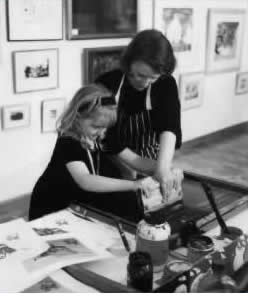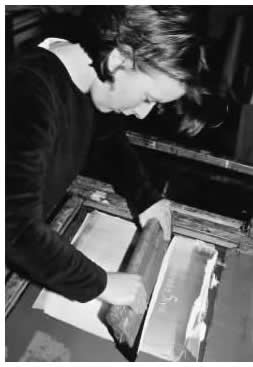 Screenprinting
is also known as silkscreen or serigraph. The screen is made of
a very fine mesh stretched tightly over a wooden or metal frame.
Originally silk fabric was used but nowadays manmade fibres such
as nylon are more common.
Screenprinting
is also known as silkscreen or serigraph. The screen is made of
a very fine mesh stretched tightly over a wooden or metal frame.
Originally silk fabric was used but nowadays manmade fibres such
as nylon are more common.
The screen is placed in the frame of a printing table and a piece of paper
placed underneath it. To make the image a fine layer of ink is pushed through
this mesh onto the printing paper using a rubber bladed squeegee.
This process must be repeated with each sheet of paper.
Screenprinting
is a direct method of printing; the image on the screen is the right way round
unlike etching, linocut & Lithography where the image
drawn onto the template is reversed.
The image is built
up using stencils to block out areas of the mesh so that the ink is
prevented from reaching the paper.
There are several types of stencil that can be used, newsprint, liquid stencils
or light sensitive emulsion.
Each time I want to print a different colour I must clean the ink and stencil
off the screen and replace it with a different stencil. Colours and tones are
gradually built up in this way
My screenprints
are original, handmade prints. I adhere to the guidelines on handmade
prints in that I create & print the image by hand, the images are
not reproductions, photographs or mechanically produced prints. I do
not make colour separations using a computer.
The edition number (total number of prints in a run) is small, usually around
25, and after the edition is complete I destroy all the stencils I use to make
it.